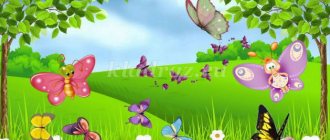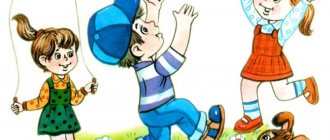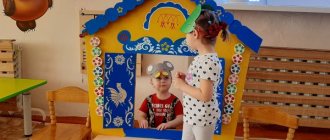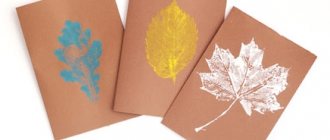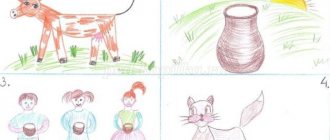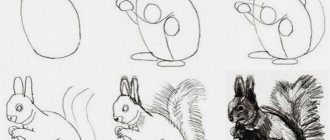Lesson summary “Repetition. Time orientation, counting"
Summary of a lesson on FEMP in a school preparatory group
Topic: “Repetition” Time orientation, counting.
Goal: To help consolidate children’s knowledge about the months of the year, the parts of the day, and the sequence of days of the week.
Objectives: Practice determining time in parts, counting forward and backward. Develop logical thinking. Train in the ability to see various geometric shapes in the image of objects, determine the spatial arrangement of objects. Cultivate friendly relationships.
Material: Toys (Winnie the Pooh, Tiger, Rabbit, donkey, pig Piglet,). Audio recording of Winnie the Pooh song, dance of little ducklings; cardboard mockup of a dial with arrows; a picture of stars; ribbons; 2 cards with logic problems; a drawing made up of geometric shapes; 3 magnetic boards with numbers.
GCD move:
Children enter the group room. A fragment of an audio recording of a Winnie the Pooh song is played.
Educator: - Guys, who sang this funny song? (children's answers). Why does he have such fun in the world? (children's answers). Winnie the Pooh has another funny song: “He who goes to visit in the morning acts wisely...” As we already know, Winnie the Pooh loved to visit his friends in the morning. What part of the day is it now? (children's answers).
Educator: Following the morning comes...? (children's answers).
Educator: Do guests often return home when it’s already...? (children's answers).
Educator Or maybe we should also go visit the heroes of this wonderful fairy tale? Take your seats on the bus. In the meantime, we'll keep going. You can help me tell a story about Winnie the Pooh. To do this, you need to listen carefully and answer questions correctly.
— One day, Winnie the Pooh invited his friends to visit: Piglet, Eeyore, Rabbit and Tigger. How many friends did he invite to visit? (children's answers).
Educator: He invited friends on Saturday and asked them to come visit the next day. On what day of the week did the guests come to Winnie the Pooh? (children's answers).
Educator: Winnie the Pooh set a time for the guests. Look at your watch. When were the guests supposed to arrive? (clock hands show 9:00) (children's answers).
Educator: They agreed to meet at the edge of the forest when the clock shows... (the clock shows 9:30) (children's answers).
Educator: Guys, Winnie the Pooh’s birthday is in March, and Eeyore’s birthday is next month. When is the donkey's birthday? (children's answers).
Educator: When Winnie the Pooh met with friends, they dreamed about how summer would come and they would go to their favorite lawn, lie on the grass and look at the night sky. What do you think can be seen in the night sky? (children's answers).
Educator: Now we will look at the sky and count the stars (one child counts the stars in direct order, the other in reverse).
Educator: This is what we learned about Winnie the Pooh and his friends. Our bus arrived at the place. Now let's go visit our friends. And so as not to get tired on the way, let's take a funny song with us! Come out and stand in a circle. (Children perform the dance of little ducklings).
Educator: Guys, now we have a difficult path ahead. Look, there is a path winding across the lawn along which we will go. This path is not easy. There will be question marks on it. This means that you will have to answer a question or complete a task. Only after your correct answers will you reach one of the fairy-tale characters. Are you ready for this challenge? Then go ahead! (children and the teacher follow the route and reach the 1st task).
Educator: Consider the task. What number should replace the sign? Why? (children's answers).
Educator: Well done, now we have reached our first friend. Go ahead.
- Look at the picture. Which figure is the odd one out here? Why? (children's answers).
— What geometric shapes does the drawing consist of? (children's answers).
— There are small toys on the sheet. Describe their location. (children's answers).
- Put the numbers in a row. Follow these steps:
- Remove neighbors of number 5;
- Remove the number that is greater than the number 3 by 2;
- Here is the number 10, remove the two numbers in front of it.
- Well done! So we helped Winnie the Pooh meet his friends. It's time for us to go back to kindergarten. Let's invite all our friends to visit and show our group. Our bus is waiting for us, take your seats. Guys, you see how many obstacles we had to go through to reach our friends. What tasks did you complete? (counted in twos; determined which figure was extra; worked with numbers)
- so we returned to kindergarten. Show the guests your favorite toys. (music turns on and children go to play)
Tasks and methods of forming temporary representations
The main tasks for developing temporary representations are:
— formation of primary practical orientation in time;
- formation of a sense of time;
— familiarization with individual “temporary” standards;
— formation of initial ideas and concepts about some properties of time (objectivity, periodicity, simultaneity).
A simplified and adapted to the psychological characteristics and level of knowledge of preschool children, the definition of the concept “time” is what determines the change of natural phenomena, various events and the duration of the existence of something in us and around us becomes the result of the material:
- Time units: basic (day, week, month, year), derivatives (hour, minute, second).
Children's acquaintance with units of time measurement should be carried out in a system of strict consistency, where knowledge of some time intervals, the ability to define and measure them, would serve as the basis for familiarization with subsequent ones and would reveal to children the essential characteristics of time: fluidity, continuity and irreversibility.
2. Instruments for measuring time: watches (hourglass, mechanical, electronic).
3. Periodic, including seasonal natural phenomena and periodic (routine) events of everyday life.
4. Properties of time.
To measure time, regularly repeating phenomena are accepted: the change of day and night, the change of lunar phases, the change of season, caused by the daily rotation of the globe around its axis, the movement of the Moon around the Earth, and the movement of the Earth around the Sun.
Deepening, clarifying and consolidating the correct understanding and use of tense terms is carried out in classes using handout didactic material.
Starting from the fourth year of life, the formation of temporary representations is carried out in mathematics classes. The main methods and techniques for this are: observations, conversations, explanations, demonstrations, artistic expression, exercises, training, didactic games, etc. Children develop knowledge about the parts of the day and the ability to distinguish between them in the process of specific observation. The teacher must ensure that children use the words: “morning”, “day”, “evening”, “night”.
When teaching children to recognize parts of the day, it is sufficient to limit themselves to correlating the correct designation of each part of the day with the corresponding period of time and teach them to determine this period by their characteristic activities and external signs.
In the learning process, it is necessary to include to a greater extent objective indicators for recognizing parts of the day - the position of the sun at different times of the day, different levels of illumination of the earth and sky, as well as the different colors of everything around us at different parts of the day.
After children have learned to identify parts of the day based on various activities, their attention should be focused on indicators that symbolize time (position of the sun, degree of illumination of the earth, color of the sky, etc.). For these purposes, observations of these phenomena during walks are organized.
Children should be taught to distinguish and correctly use the words: “today,” “tomorrow,” “yesterday.” You can use the following exercises with specific, understandable content: “Today we have a math lesson. What was your activity yesterday? Tomorrow we will have a drawing lesson. What song did you sing in music class yesterday?”
The concept of “fast” and “slow” is formed in children in the process of direct observations of their actions and the actions of adults, animals, birds, etc.
In order to consolidate acquired knowledge, various exercises and didactic games are used, in which visual aids are widely used. Children are organized to look at paintings, illustrations, photographs, which, through the content of the activity depicted in the picture and some objective indicators, help the child determine and name the time.
Particular attention is paid to learning to distinguish between parts of the day, observing not only the work of people, but also the position of the sun. Through observations and comparisons, children are explained the concepts of “vault of heaven,” “sunset,” “horizon,” and are given the opportunity to make sure that the sun moves across the vault of heaven throughout the day. During the day, compared to morning and evening, the sun rises above the horizon, and shadows from objects become short. The period of the day when the sun is high in the sky and children are playing in the garden is called “noon”, this is the middle of the day. Based on direct observations and examination of corresponding reproductions of paintings, children of this age group are introduced to the phenomena: “sunset”, “sunrise”, “twilight”, “dawn” and explain why they say about these periods of the day: “dusk”, “dawn” " Children are explained that the total duration of morning, day, evening and night is a day. When children learn the concept of “day,” a number of techniques are used: showing pictures, asking questions, playing games, etc.
Features of the formation of temporary representations in different age groups - older age
Children in the older group consolidate and deepen their understanding of units and some features of time. The name of the parts of the day is associated not only with the specific content of the activities of children and adults who surround them, but also with more objective indicators of time - natural phenomena. Children get acquainted with the seasons, the names of the days of the week, determine what day of the week was yesterday, what it is today, what it will be tomorrow.
In work, it is necessary to widely use such methods as: observations, conversations, reading, retelling fairy tales, poems, looking at paintings, photographs, didactic games and exercises, focusing on the familiar periodicity of day and night.
Older preschoolers need to form conscious concepts about the day. During the learning process, attention is paid to the cyclical change of day and night. Nature itself suggested to people a way to divide time according to the principle: day and night - day. To correctly understand the day, children must realize that the day can be divided into four parts: morning, afternoon, evening, night.
Older preschoolers distinguish and name parts of the day, focusing on sunrise and sunset. In the process of observing natural phenomena, they learn the concepts: at dawn, at dusk, at noon, at midnight. To form these ideas, the teacher uses, first of all, observations, looking at plot paintings, as well as reading fiction and learning poems.
Familiarization with the days of the week already in the senior group should be combined with the formation of knowledge about the week as a measure of working time. Focusing on the fact that people work five days a week and rest two days helps to understand the quantitative composition of the number 7 (days of the week).
Experience shows that not all days of the week are remembered equally easily and quickly. The best days to remember are Sunday, Saturday and Monday.
In addition, in the older group, work is being done to develop children’s ideas about the seasons. In this case, pictures and verbal material are widely used: stories, fairy tales, poems, riddles, proverbs.
In the older group, the teacher develops a “sense of time”, an understanding of its meaning in people’s lives, and the irreversibility of time. In this group there is an opportunity to familiarize children with a three-dimensional model of time, by which they can understand the continuity, irreversibility, and symmetry of time.
